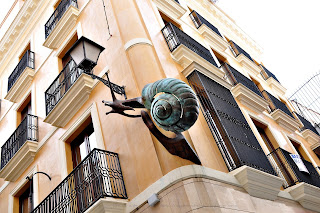Viva La Espana ~ Séville


Séville, the artistic, historic,
cultural, and financial capital of southern Spain. It is the capital of
the autonomous community of Andalusia and of the province of Seville.
Seville has a history of more than 2,000 years. The passage of the various
civilizations, instrumental in its growth, has left the city a distinct
personality, and a large and well-preserved historical center. Although
it has a strong medieval, renaissance and baroque heritage, the city
received heavy influences from Arabic culture. In mythology, the founder of the city is considered Hercules. Seville has seen itself through Moorish rule, Castilian rule, Golden Age and a Civil War.
Getting to Séville is possible by Renfe AVE high-speed train. The train ride took around 2.5h from Madrid-Atocha Station. This leg of the train ride is rather costly. From the Seville train station, the best way to get to the city centre is via a taxi, especially if you have big luggage to handle.
We managed to find a reasonably-priced hostal in the best location ever. We are just beside the Seville Cathedral and getting the to cathedral takes only 3-5 mins on foot. Around our accomodation are narrow streets lined with highly-recommended tapas bars. There is no place better.
We got ourselves a ground level room with a bay window looking out into the streets.
A vehicle navigating its way through the narrow streets.
Canopies a lined across streets to provide a cooling shade from the scorching sun.
One long street lined with shops.
A style of architecture unique to the south.
Orange trees can be found everywhere in streets of Seville.
Monument outside El Corte Ingles.
An electric tram runs through the city centre.
Metropol Parasol, located on La Encarnación square, a monumental
umbrella-like building designed by the German architect Jürgen Mayer, completed in August 2011. The Metropol Parasol is the largest outdoor wooden structure in the world. This modern architecture structure houses the central
market and an underground archaeological complex. The terrace roof is a
city viewpoint.
Seville Cathedral and La Giralda, was built from 1401–1519 on the former site of the city's mosque. It is the
largest of all medieval and Gothic cathedrals. The interior is the longest nave in Spain, and is lavishly
decorated, with a large quantity of gold. The Cathedral reused
some columns and elements from the mosque, and, most famously, the
Giralda, originally a minaret, was converted into a bell tower. It is
topped with a statue, known locally as El Giraldillo, representing
Faith. The tower's interior was built with ramps rather than stairs, to
allow the Muezzin and others to ride on horseback to the top. The Seville Cathedral is the most beautiful Gothic cathedral that I have ever been to. It is definitely a must-visit in Spain.
This is a small church on the side of the Seville Cathedral, free entry.
The entrance to the main Cathedral.
Standing at the entrance of the Cathedral is replica of the El Giraldillo.
A fee is required to tour the Cathedral.
The choir stalls of the Cathedral is located in the centre of the Cathedral, unlike other cathedrals.
This allows the music to resonate through the entire Cathedral.
This Cathedral has also seen royal marriages taking place.
The Cathedral also houses some precious relics and artefacts in its treasury.
The final resting place of Christopher Columbus resides in the Seville Cathedral.
The bell tower on top of the La Giralda.
Dining in Seville is all about tapas! We visited one of the recommended tapas bar to savour the best tapas in Seville.
A sandwich with Iberian ham. The way to eat this is to drizzle olive oil onto the bread and savour the taste.
A pie with mixed nuts and vegetables.
Scallops with marinara,
Grilled squids the way the local love it.
Iberian ham sandwich.
Plaza de España, in Maria Luisa
Park (Parque de Maria Luisa), was built by the architect Aníbal González
for the 1929 Exposición Ibero-Americana. It is an outstanding example
of Regionalist Revival Architecture, a bizarre and lofty mixture of
diverse historic styles, such as Art Deco and Neo-Mudéjar and lavishly
ornamented with typical glazed tiles. The Plaza de Espana is a showcase of the Spanish empire during its peak.
To view all the pictures of Seville, visit Complete Seville Album here: http://tinyurl.com/69eo2rd
Photography by WiFi
©2011 a day in the life of a bearbrick

































































Comments